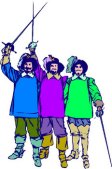By Ekaterina Zhdanova-Redman

|
France - History
By Ekaterina Zhdanova-Redman |

|
 1 Although humans have inhabited the land now known as France for almost 100,000 years, the country of France didn't begin formation until around 200-100 B.C., when the neighboring Roman Empire began making raids on what was then called Gaul and the Celtic natives of the land. As a result of these Gallic Wars, Roman emperor Julius Caesar conquered the entirety of Gaul for the Roman Empire by 51 B.C. The Celts that lived in Gaul took on Roman customs and even a form of Latin, the official language of the Romans. The Celts of Gaul lived under Roman rule until the third century AD.
1 Although humans have inhabited the land now known as France for almost 100,000 years, the country of France didn't begin formation until around 200-100 B.C., when the neighboring Roman Empire began making raids on what was then called Gaul and the Celtic natives of the land. As a result of these Gallic Wars, Roman emperor Julius Caesar conquered the entirety of Gaul for the Roman Empire by 51 B.C. The Celts that lived in Gaul took on Roman customs and even a form of Latin, the official language of the Romans. The Celts of Gaul lived under Roman rule until the third century AD. |
Create Weekly Reading Books
Prepare for an entire week at once! |
| Leave your feedback on France - History (Grades 6-7) (use this link if you found an error in the story) |